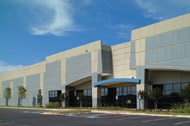|
COVER STORY, APRIL 2010
A SLOW BUILD
Industrial markets gaining traction in stabilizing economy.
Jon Ross
 |
A good example of industrial activity in the Atlanta market is at IDI’s Westfork Business Park in Lithia Springs, Ga., where Global Experience Specialists and Bunzl Distribution Southeast have renewed or expanded leases totaling 428,081 square feet.
|
|
A commonplace tactic of the recession has been to deplete warehouse inventories to barebones levels. Industrial tenants adjusted to the changing economic environment and its casualties — fewer workers, less industrial space — by choosing to produce fewer units. Last year’s holiday season caused an uptick in manufacturing simply because warehouses were being kept at unsustainable levels. Industrial markets throughout the Southeast experienced a slight manufacturing boost — if they felt one at all — because tenants had no choice but to produce new goods to match the slight increase in consumer demand.
“As quickly as that bump came, it went away,” says Dave McGahren, a senior vice president in Cassidy Turley’s Brentwood, Tennessee, office. Now that consumer demand has ebbed, warehouse users have gone back to low levels of product, something that is quickly becoming the status quo. “The big factories are still so far back that their inventories of raw materials are at an all-time low,” he continues. “Some of the issues with vacancy in our markets are the result of, as leases roll and inventories have been reduced, tenants don’t need as much space.”
What happens, however, when demand churns up again? Brokers throughout the Southeast have been staring down this question, knowing that a sudden, huge jolt in consumer demand could lead to increase cost for consumers. “Increase in demand, reduction in supply — logic would say prices will probably go up,” McGahren says. “Overseas shipping from China — the freight companies have decommissioned a lot of the ships that bring freight in from overseas. The result of that is more lag time in delivery of products,”
While the industrial markets won’t experience any growth from this latest consumer interest, brokers are still relatively enthusiastic about the future of the industrial markets. In Nashville, McGahren says business growth is needed in order to awaken the slumbering industrial markets. When lenders start lending and corporate owners start feeling better about the economy, industrial vacancies will evaporate. The increase in employment that comes hand-in-hand with business growth will revive consumer confidence, which results, down the line, in increased manufacturing and distribution. But for now, it’s difficult getting anything done. “Decision makers are afraid to stick their neck out a little too far,” he says. “The result of that is they do nothing. It’s just a lockdown.”
McGahren says he hasn’t seen any true investment sales in the Nashville industrial market since 2007. Leasing activity is slow, and rental rates are low. To add to the area’s poor occupancy rate, a 2 million-square-foot tenant will move out of its space in the next 6 to 8 months because of a lost contract. McGahren, however, has hope. “Our industrial market is struggling, but overall, the Nashville economy has done well and continues to be relatively stable,” McGahren says.
Industrial landlords in Atlanta only saw a tiny jump due to consumer spending around the holidays. These owners know that it won’t be easy to find new clients in the current economy, so they’re doing all they can to keep tenants in place. When outside interest comes along, landlords have been willing to throw incentives at prospective tenants in order to bring down vacancy rates.
“There was a time period in there where landlords had the mentality that they were going to wait it out, and I think they started to understand that this down part of the market is going to be here for a while,” says Bill Doran of Atlanta-based Carter. “They need to do what they need to do to achieve occupancy in the buildings.”
On the tenant side, companies are feeling more willing to pursue space in the current market. Corporate firms have seen a relative calm and are ready to get back into the game. “The financial markets have stabilized somewhat. There’s a little bit of lending going on. Everything’s not up in the air as much. They’re getting their footing back a little bit,” he says. “A year ago, no matter how good the deal was, they just couldn’t make a decision because they had no clue as to what the future was going to bring.”
The manufacturing bump wasn’t felt at all in Miami, but CB Richard Ellis’ Brad Smith says the market is more active than it was 6 months ago.
“The initial panic and fear has settled,” he says. “Sure, we’re in for a slow, long recovery, but I think people are now starting to look at this as planning instead of just survival and seeing that there are some great opportunities out there, especially in the leasing market.”
For the most part, tenants and buyers are looking around in the market and taking their time, but there have also been some smaller deals. Smith says tenants looking for 50,000-square-foot blocks exist. Port activity is churning along, with users in the 15,000-square-foot to 20,0000-square-foot range active in the market. This will likely be how things progress for the rest of the year.
“2010, I don’t think is going to have any earth-shattering types of numbers in terms of absorption, but I think it’s plateaued off in terms of the amount of big blocks of space coming on to the market,” Smith says. “We know what we’re dealing with now, and slowly but surely, it will start to fill as opportunistic buyers and tenants start to come out of the woodwork.”
©2010 France Publications, Inc. Duplication
or reproduction of this article not permitted without authorization
from France Publications, Inc. For information on reprints
of this article contact Barbara
Sherer at (630) 554-6054.
|
